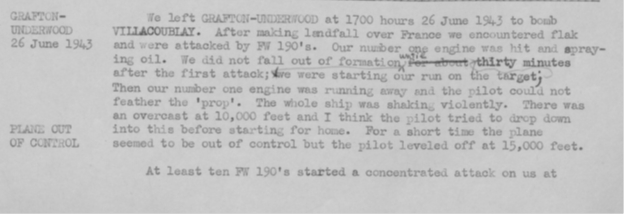 “We left Grafton-Underwood at 1700 hours 26 June 1943 to bomb Villacoublay. After making landfall over France we encountered flak and were attacked by FW-190’s….The whole ship was shaking violently…”
“We left Grafton-Underwood at 1700 hours 26 June 1943 to bomb Villacoublay. After making landfall over France we encountered flak and were attacked by FW-190’s….The whole ship was shaking violently…”
Recently released by the National Archives, digitized Escape and Evasion Reports are now available for download in PDF format to your eReader of choice.

Detailed firsthand accounts of harrowing escapes and near-captures by Axis occupiers, Allied aircrew no longer remain faceless. Instead, we learn their names, hometowns and quite possibly a new view of World War II that up until now was not available online.
The fastest way of getting to the reports is via the link from the NARAnations blog. Clicking on the link, http://arcweb.archives.gov/arc/action/ExternalIdSearch?id=305270, will bring you to the main entry for all the reports. Once there you can browse the list or do further searching, depending upon what subject or person(s) you might be interested in.
Additional tabs at the top give you more background and information about the reports, including Scope & Content, Archived copies (where the actual materials are stored), and Hierarchy, or where this particular report fits into the larger collections made available by the National Archives.
Choosing to browse the reports en masse results in a long list of individual names. While it’s fun to look at individual’s reports, this can prove quite time consuming if you are looking for something specific. Searching within the results of all the reports, which is an option, might prove more fruitful.
Selecting a name and clicking on it will bring you to the main entry point for the resource. While there is some basic information about the person and subject, etc., your best results will be in actually downloading the PDF.
It’s important to note that the reports I did download and sample had been scanned in as images and were not searchable within their contents. To be perfectly honest, however, in all actuality, OCR’ing these reports would be difficult as they are a mixture of handwritten interviews mixed with typewritten official documents.

From the eReader standpoint, you should be able to transfer and view the reports without too many problems as most devices now support PDF formats, albeit not always easily in some cases.
There’s also the issue of reading a PDF on a small device such as the phone or iPod, but zoom controls, etc. can help to make things more legible.
Along these same lines, there might be some issues with some older devices with limited memory and weaker processors. Given these files are in image-driven PDF, you might have to wait an extra minute or two for them to render on screen.
Even with these limitations, this remains a wonderful resource if you are a World War II buff or historian and helps to bring a face or a name to a mass of reports that might not have otherwise been made available. If you have a moment give it a try. Below, you will find links to the actual site as well as NARA to get you started. Have fun!
Links:
NARAnations blog release: http://blogs.archives.gov/online-public-access/?p=2751
Archival Research Catalog link to reports: http://arcweb.archives.gov/arc/action/ExternalIdSearch?id=305270
Images courtesy National Archives, http://www.archives.gov/, and are VLC snapshots of multimedia available on site. War poster courtesy National Archives war poster collection.
[donotprint]Digg us. Slashdot us. Facebook us. Twitter us. Share the news.












 [/donotprint]
[/donotprint]